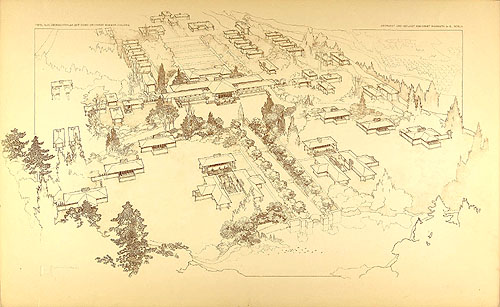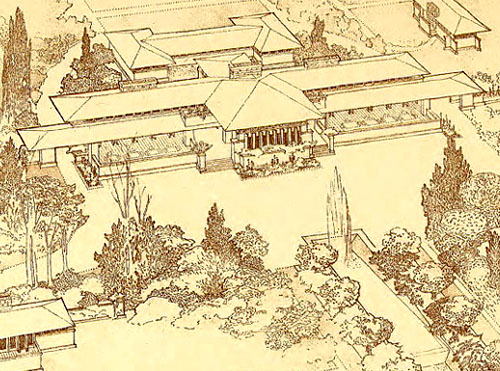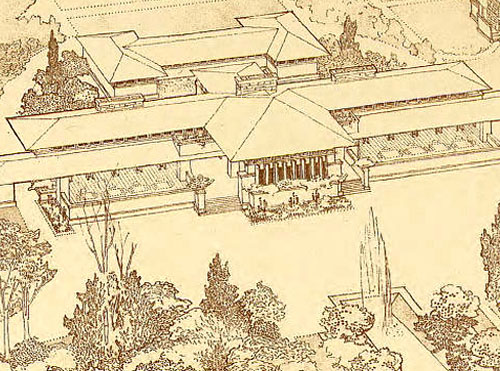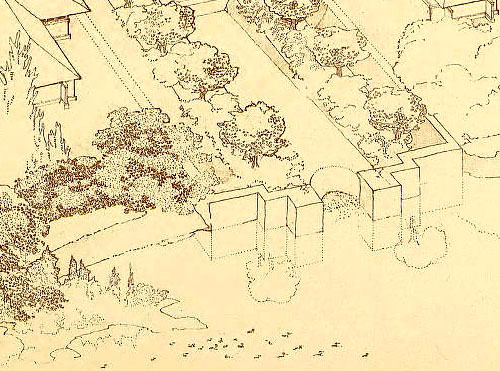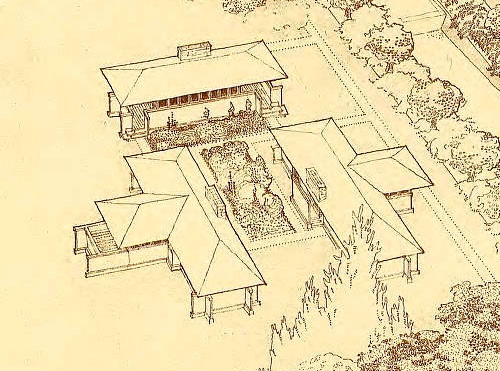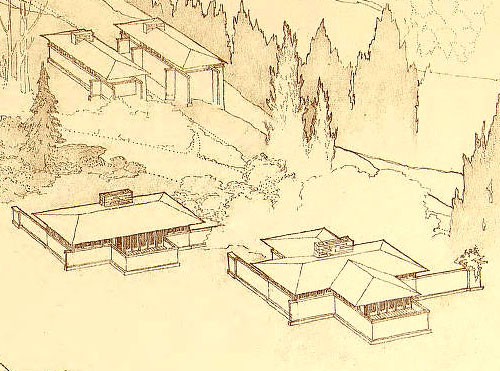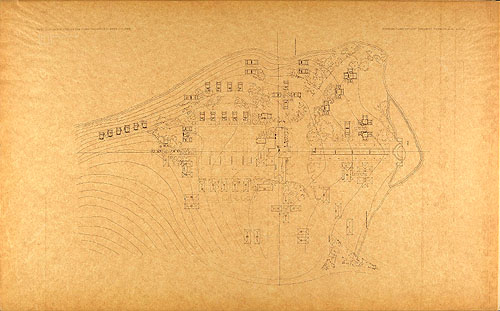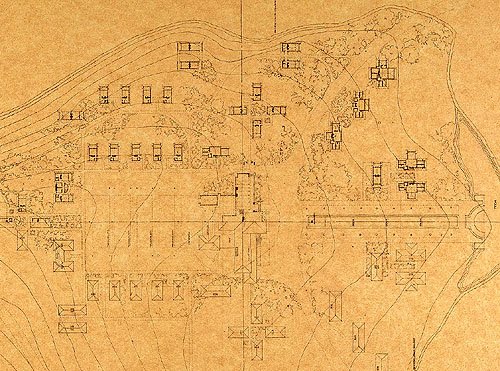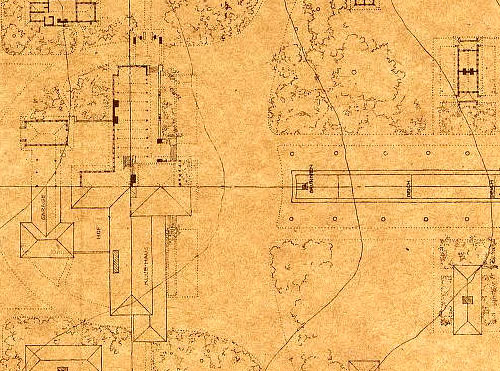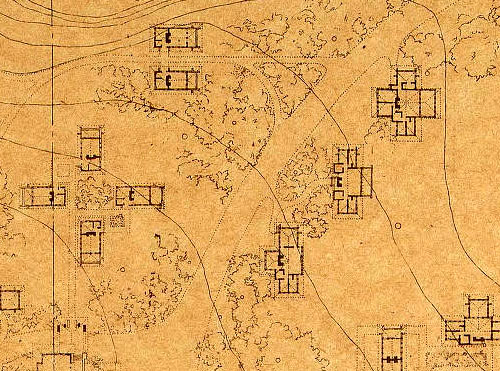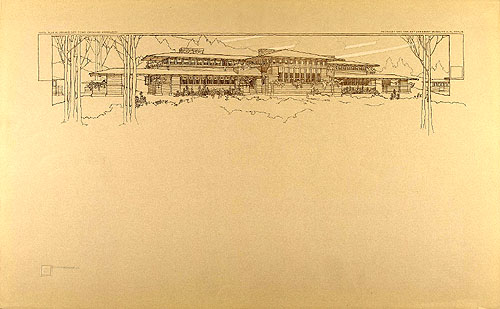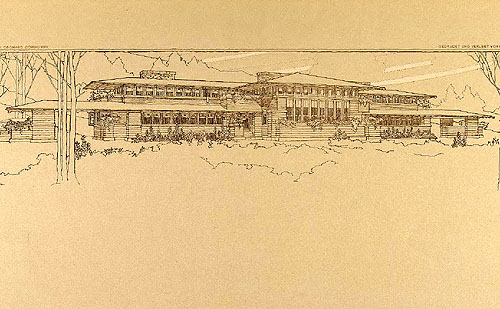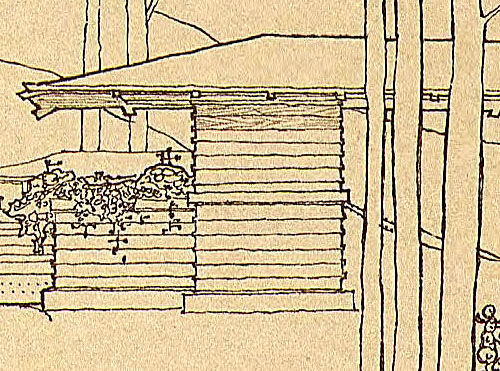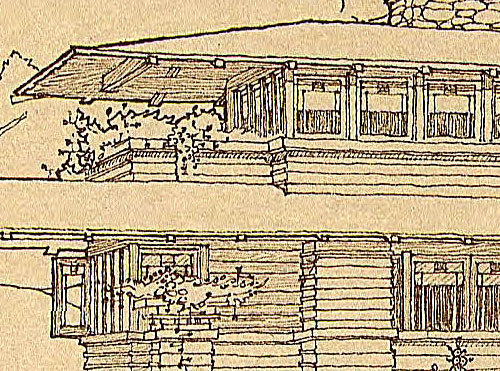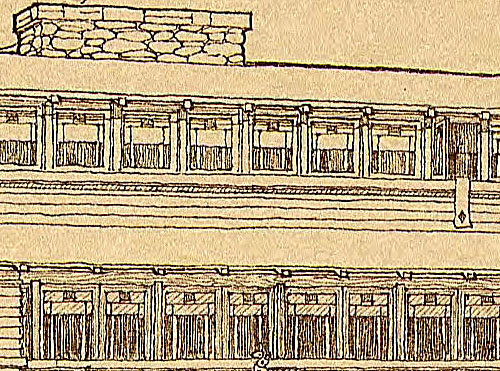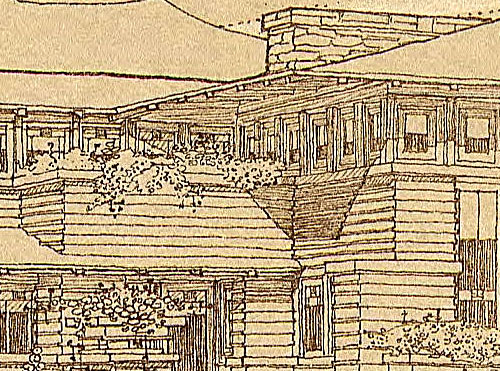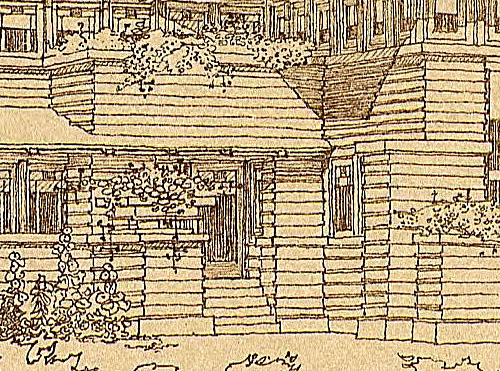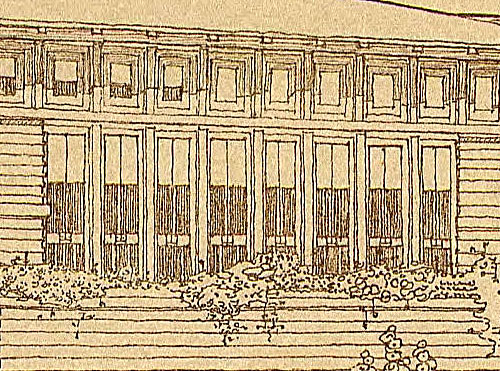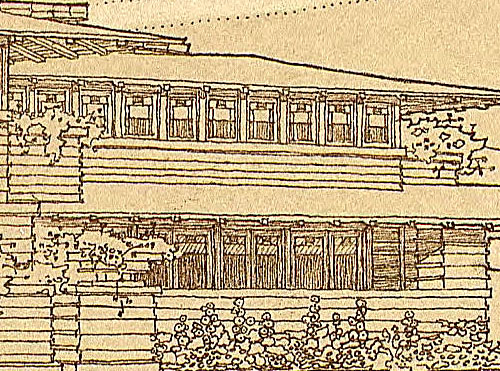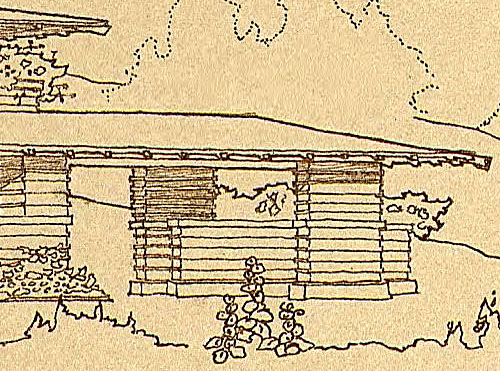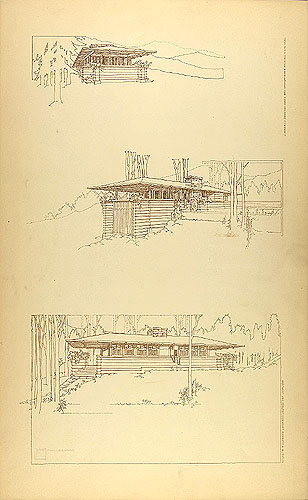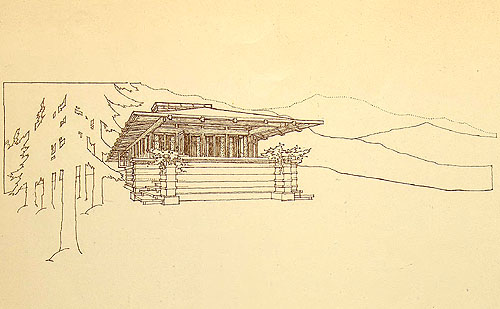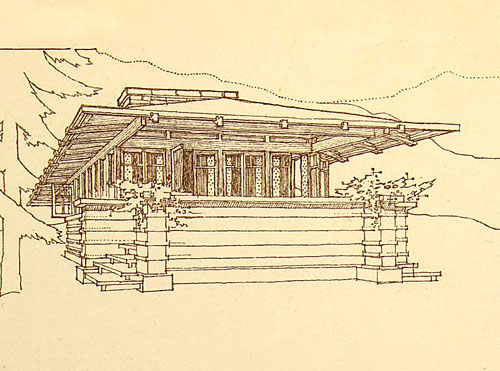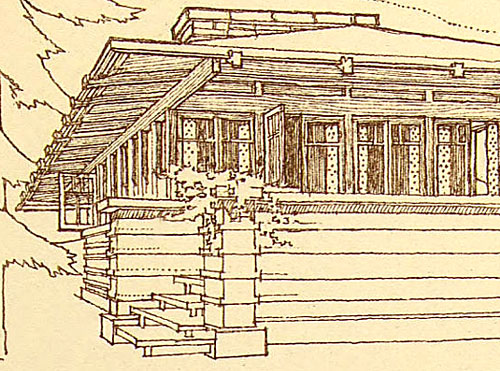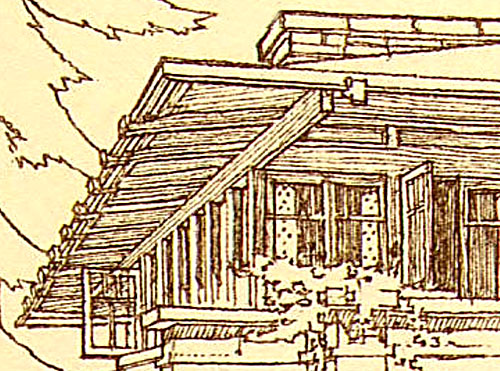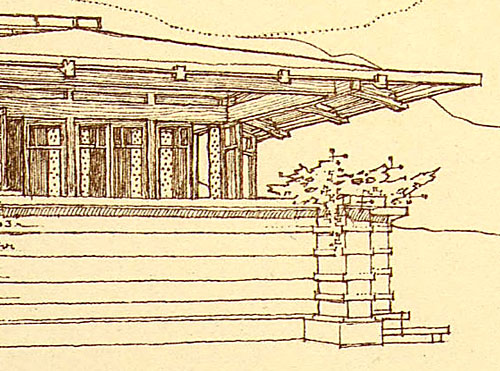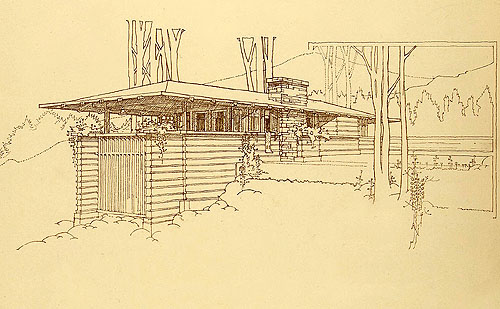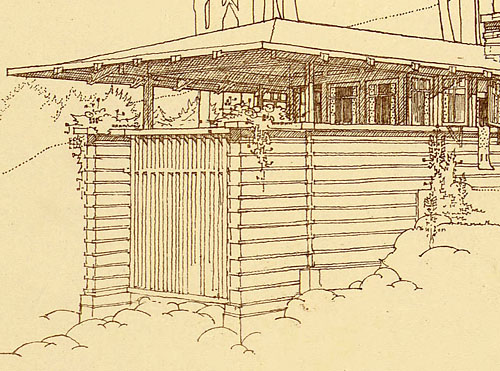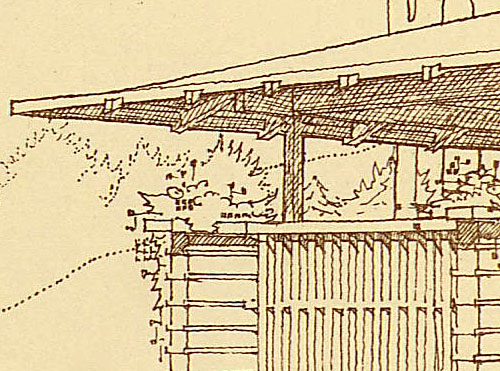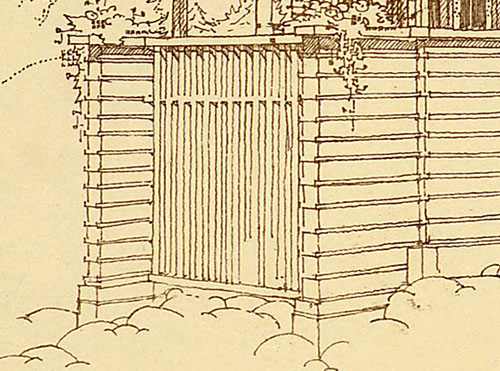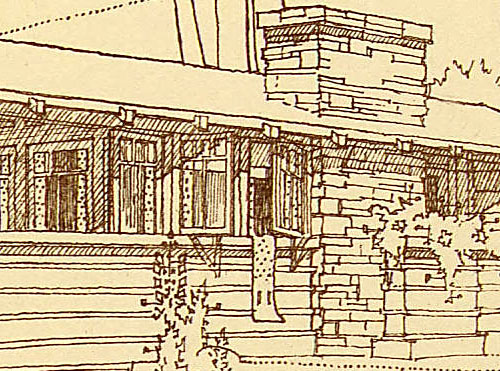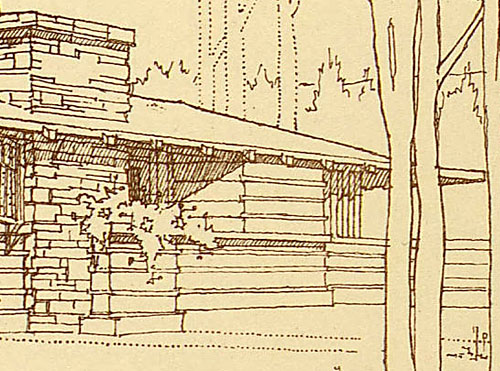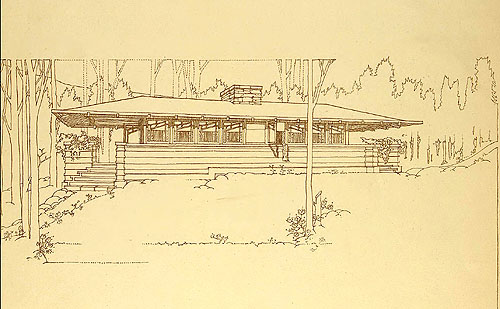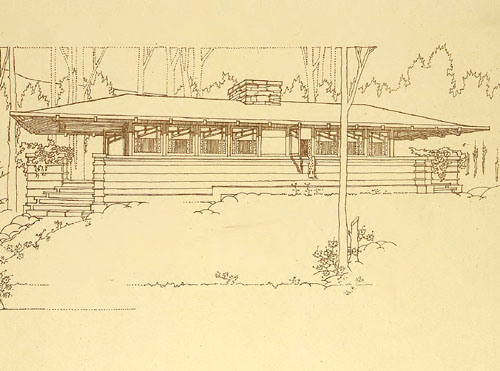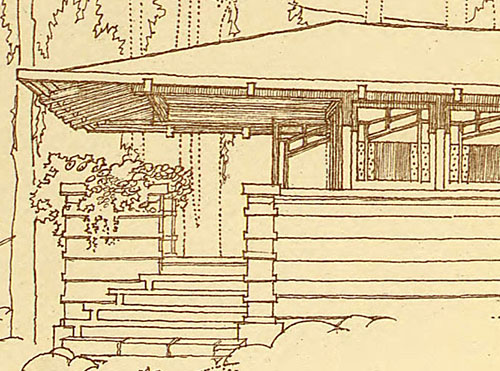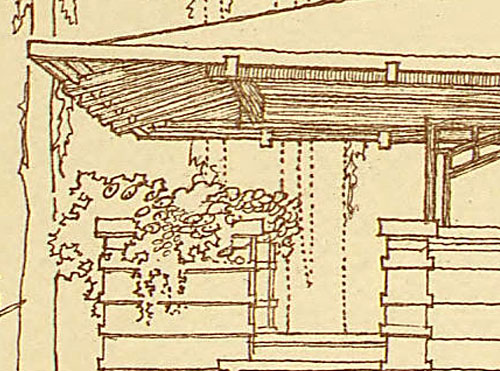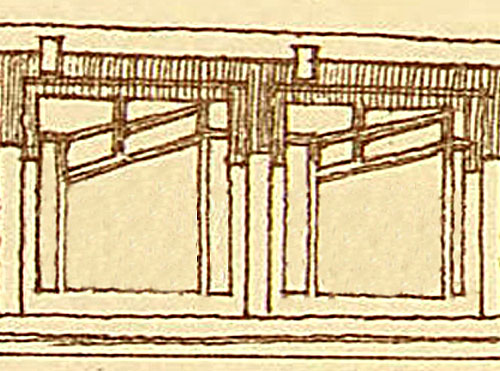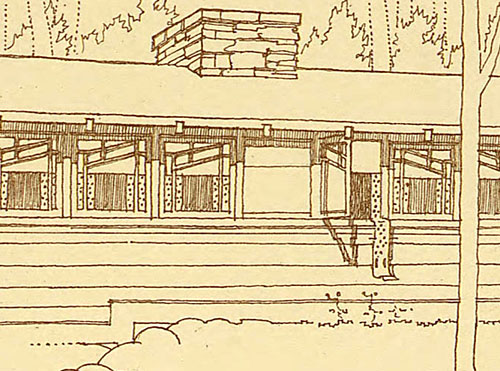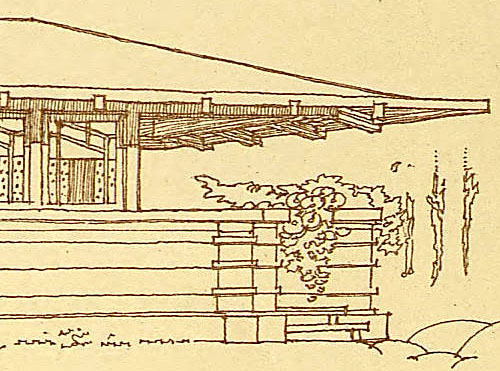[flw/_Private/Navbar Be-mail.htm]
Como Orchard Summer Colony (University Heights), Darby, Montana (1909) (S.144)
Four Plates from the Wasmuth Portfolio, 1910 In 1910, Ernst Wasmuth the German publisher produced a pair of portfolios covering the work of Frank Lloyd Wright entitled "Ausgeführte Bauten und Entwürfe von Frank Lloyd Wright". The "Wasmuth Portfolios" secured Wright's reputation in Europe and enormously influence the architects of the day. Printed in German, the two portfolios consist of 100 separate plates. 72 plates were numbered I through LXIV and included eight with a or b. 28 were tissue overlays and were attached to the corresponding plates. There were only four projects Wright devoted four sheets to. The Como OrchardSummer Colony was one. The other three were the Susan L. Dana Residence, the Avery Coonley Residence and Unity Temple. The four Como Orchard plates included: Plate XLVI(a). General Perspective of Como Orchard Summer Colony. Plate XLVI(b). Plan of the Como Orchard Summer Colony (tissue site plan). Plate XLVII(a). Central club house for the Como Orchard Summer Colony. Plate XLVII(b). Typical cottages, Como Orchard Summer Colony. Although four plates were devoted to the portfolio, no photographs of Como Orchards was published in "Frank Lloyd Wright, Ausgeführte Bauten" 1911. This may have been a result of changes, alterations, cutbacks and that Wright lost money himself on the project.
The Como Orchard Summer Colony, consisted of the Master Plan, the Clubhouse and Inn, Cottages and the Manager’s Office. Developed for the Como Orchard Land Company, a subsidiary of the Bitter Root Valley Irrigation Company, they were marketed to University of Chicago Professors as "University Heights Community and Orchards." The area is still called University Heights today. Purchase five to ten acres and a cottage, and the company would manage the orchard and market the crop. Perfectfor a professor. Vacation for three months and enjoy the Bitterroot Valley. The Clubhouse was conceived as the center of the community. It consisted of two communal Dining Rooms, one on either side, a two story lounge in the center for gathering, three fireplaces, guest bedrooms upstairs, a kitchen and servants rooms, and large porches that ran the length of the front. An open balcony overlooked the lounge. With communal Dining Rooms in the Clubhouse, most Cottages were designed without kitchens. All buildings were board and batten, the windows were designed with wood mullions. An irrigation channel from Lake Como ran through the development’s 1600 acres. Of the over fifty cottages that were planned, twelve were constructed. Today, one Cottage and the Manager’s office remain and are maintained.
There were many classic Prairie styled Wright details in the Clubhouse and original Cottages. The basic material was wood, utilizing horizontal board and batten siding. Strong horizontal lines, low-pitched roof, broad overhanging eaves, horizontal rows of mullion divided glass windows and glass doors, centrally located stone fireplaces and chimneys, balconies and porches. Wright designed built-in planters like many of his buildings at that time, but they were eliminated when constructed to keep costs in line. Although the Cottages were economically built, Wright details still exist. Partition walls like those he designed in Usonian homes. Mullion windows, stone fireplaces and designed ceiling details. They were built as summer Cottages so lacked central heating.
Wright visited the site in February 1909, construction began in May. One of Wright’s drawings of the Clubhouse was a winter scene, no doubt a result of his February visit.
General Perspective Site Plan Clubhouse Cottages Plate XLVI(a). General Perspective of Como Orchard Summer Colony 1: Plate XLVI(a). Viewed from the Southeast. The General Perspective placed the Clubhouse in the center. Fifty-nine cottages were proposed in clusters around the Clubhouse. The six western cottages are not shown on this plate (see site plate). The Clubhouse looked east toward the Bitterroot Valley. Wright designed a beautiful tree-lined three leveled water feature with sidewalks on either side. It began with a large fountain. Each level (pool) had a waterfall that cascaded down toward the man-made pond. The final waterfall flowed over a semi-circle. The back of the clubhouse faced West toward the Bitterroot Mountains and looked out over the Garage and five Tennis Courts. 2: The Clubhouse looked east toward the Bitterroot Valley. Wright designed a beautiful tree-lined three leveled water feature with sidewalks on either side. It began with a large fountain. Each level (pool) had a waterfall that cascaded down toward the man-made pond. Each end had a porte cochere (carriage entrance passing through a building) with stairs that lead up to expansive partially covered porches. The back of the clubhouse faced West toward the Bitterroot Mountains and looked out over the Garage with Stores on either end. Past that were five Tennis Courts. 3: The Clubhouse was conceived as the center of the community. It consisted of two communal Dining Rooms, one on either side, a two story lounge in the center for gathering, three fireplaces, guest bedrooms upstairs, a kitchen and servants rooms. An open second story balcony overlooked the lounge. Each end had a porte cochere (carriage entrance) with stairs that lead up to expansive partially covered porches. Dining Room doors were designed to open outward onto the porches. Wright designed built-in planters and vases like many of his buildings at that time, but they were eliminated when constructed to keep costs in line.
4: The Clubhouse looked east toward the Bitterroot Valley. Wright designed a beautiful tree-lined three leveled water feature with sidewalks on either side. Each level (pool) had a waterfall that cascaded down toward the man-made pond. The final waterfall flowed over a semi-circle. 5: Fifty-nine cottages were proposed in clusters around the Clubhouse. 6: Of the fifty-nine cottages shown in this plate, the cottage on the far right is the only example of the last remaining cottage.
Plate XLVI(b). Plan of the Como Orchard Summer Colony 1: Plate XLVI(b). The Site Plan (tissue), placed the Clubhouse in the center. Fifty-nine cottages were proposed in clusters around the Clubhouse. The Clubhouse looked east toward the Bitterroot Valley. Wright designed a beautiful tree-lined three leveled (four in site plan) water feature with sidewalks on either side. It began with a large fountain. Each level (pool) had a waterfall that cascaded down toward the man-made pond. The final waterfall flowed over a semi-circle. The back of the clubhouse faced West toward the Bitterroot Mountains and looked out over the Garage and five Tennis Courts. 2: Detail of the site plan. Fifty-nine cottages were proposed in clusters around the Clubhouse. The Clubhouse looked east toward the Bitterroot Valley. Wright designed a beautiful tree-lined three leveled (four in site plan) water feature with sidewalks on either side. It began with a large fountain. Each level (pool) had a waterfall that cascaded down toward the man-made pond. The final waterfall flowed over a semi-circle. The back of the clubhouse faced West toward the Bitterroot Mountains and looked out over the Garage and five Tennis Courts. 3: The Clubhouse looked east out to a beautiful tree-lined three leveled (four in site plan) water feature with sidewalks on either side. It began with a large fountain. Behind the clubhouse was the Garage. 6: Of the fifty-nine cottages shown in this plate, the cottage on the top right is the only example of the last remaining cottage. Plate XLVII(a). Central Club House the Como Orchard Summer Colony 1: Plate XLVII(b). Viewed from the Southeast. The Clubhouse was conceived as the center of the community. It consisted of two communal Dining Rooms, one on either side, a two story lounge in the center for gathering, three fireplaces, guest bedrooms upstairs, a kitchen and servants rooms. An open second story balcony overlooked the lounge. Each end had a porte cochere (carriage entrance) with stairs that lead up to expansive partially covered porches. Dining Room doors were designed to open outward onto the porches. There were many classic Prairie styled Wright details in the Clubhouse. It was constructed of wood, utilizing horizontal board and batten siding. Strong horizontal lines, low-pitched roof, broad overhanging eaves, horizontal rows of mullion divided glass windows and glass doors, centrally located stone fireplaces and chimneys, balconies and porches. Wright designed built-in planters and added large vases like many of his buildings at that time, but they were eliminated when constructed to keep costs in line. 2: The Clubhouse was conceived as the center of the community. It consisted of two communal Dining Rooms, one on either side, a two story lounge in the center for gathering, three fireplaces, guest bedrooms upstairs, a kitchen and servants rooms. An open second story balcony overlooked the lounge. Each end had a porte cochere (carriage entrance) with stairs that lead up to expansive partially covered porches. Dining Room doors were designed to open outward onto the porches. There were many classic Prairie styled Wright details in the Clubhouse. It was constructed of wood, utilizing horizontal board and batten siding. Strong horizontal lines, low-pitched roof, broad overhanging eaves, horizontal rows of mullion divided glass windows and glass doors, centrally located stone fireplaces and chimneys, balconies and porches. Wright designed built-in planters and added large vases like many of his buildings at that time, but they were eliminated when constructed to keep costs in line. 3: Each end of the Clubhouse had a porte cochere (carriage entrance). Strong horizontal lines, low-pitched roof, broad overhanging eaves and built-in planters. 4: Built-in planter, balcony and guest bedrooms upstairs. Strong horizontal lines, low-pitched roof, broad overhanging eaves, horizontal rows of mullion divided glass windows and glass doors. Wright added a large signature vases like in many of his buildings at that time. It were eliminated when constructed. 5: The Clubhouse included three stone fireplaces, guest bedrooms upstairs, and horizontal rows of mullion divided glass windows that opened outward. Wright even included a cloth hung on the window sill. Dining Room doors were designed to open outward onto the porches. 6: Built-in planters, balconies and guest bedrooms were upstairs. An open second story balcony overlooked the lounge on the right. Strong horizontal lines, low-pitched roof, broad overhanging eaves large fireplaces, large vases, all classic Wright details. 7: Wright designed elaborate built-in planters and large vases like many of his buildings at that time, but they were eliminated when constructed. Stairs lead to expansive partially covered porches. Strong horizontal lines, low-pitched roof, broad overhanging eaves, horizontal rows of mullion divided glass windows and glass doors, balconies and porches. 8: The center of the Clubhouse included a two story lounge in the center for gathering, an open second story balcony overlooked the lounge and built-in planters on the outside. 9: Built-in planter, balcony and guest bedrooms upstairs. Strong horizontal lines, low-pitched roof, broad overhanging eaves, horizontal rows of mullion divided glass windows and glass doors. Wright added a large signature vases like in many of his buildings at that time. It were eliminated when constructed. 10: Each end of the Clubhouse had a porte cochere (carriage entrance). Strong horizontal lines, low-pitched roof, broad overhanging eaves and built-in planters.
Plate XLVII(b). Typical cottages, Como Orchard Summer Colony (Three versions)
Wright included three variations of the small cottage. Options were many. A single living room with fireplace and porch. A "duplex", two living rooms, fireplaces in the center, and porches on either end. A living room, bedroom, bath and porch. Two parallel cabins with bedrooms in between forming two, two bedroom duplexes. Options were available on larger units by adding bedrooms, a kitchen or dining room. There were many classic Prairie styled Wright details in the original Cottages. The basic material was wood, utilizing horizontal board and batten siding. Strong horizontal lines, low-pitched roof, broad overhanging eaves, horizontal rows of mullion divided glass windows, centrally located stone fireplace and chimney, porches. Wright designed built-in planters like many of his buildings at that time. Although the Cottages were economically built, Wright details still exist. Partition walls like those he designed in Usonian homes. Mullion windows, stone fireplaces and designed ceiling details. They were built as summer Cottages so lacked central heating. 1a: This version appears to be a "duplex", two living rooms, fireplaces in the center, and porches on either end. Strong horizontal lines, low-pitched roof, broad overhanging eaves, horizontal rows of mullion divided glass windows, centrally located stone fireplace and chimney, porches. Wright designed built-in planters like many of his buildings at that time. Although the Cottages were economically built, Wright details still exist. Partition walls like those he designed in Usonian homes. Mullion windows, stone fireplaces and designed ceiling details. They were built as summer Cottages so lacked central heating. 1b: Strong horizontal lines, low-pitched roof, broad overhanging eaves, horizontal rows of mullion divided glass windows, centrally located stone fireplace and chimney, porches. Wright designed built-in planters like many of his buildings at that time. 1c: Though simple in design, Wright was able to retain many classic prairie styled details. Strong horizontal lines, low-pitched roof, broad overhanging eaves, 1d: Though simple in design, Wright was able to retain many classic prairie styled details. Strong horizontal lines, low-pitched roof, broad overhanging eaves, 1d: Strong horizontal lines, low-pitched cantilevered roof, broad overhanging eaves, horizontal rows of windows, and porches. Wright designed built-in planters like many of his buildings at that time. 2a: This version appears to be a living room, bedroom, bath and porch. Strong horizontal lines, low-pitched roof, broad overhanging eaves, horizontal rows of windows, centrally located stone fireplace and chimney, porches. Wright designed built-in planters like many of his buildings at that time. Although the Cottages were economically built, Wright details still exist. Partition walls like those he designed in Usonian homes. Mullion windows, stone fireplaces and designed ceiling details. They were built as summer Cottages so lacked central heating. 2b: This version extended the front porch, with the added vertical roof supports. Wright also added the vertical detail to the front porch. 2c: This version extended the front porch, with the added vertical roof supports. Wright designed built-in planters like many of his buildings at that time. 2d: Wright added vertical detail to the front porch. 2e: Horizontal rows of windows, centrally located stone fireplace and chimney. Wright even included a cloth hung on the window sill. 2f: Strong horizontals. Centrally located stone fireplace and chimney.
3a: This version appears to be a "duplex", two living rooms, joined fireplaces in the center, and porches on either end. Strong horizontal lines, low-pitched cantilevered roof, broad overhanging eaves, horizontal rows of mullion divided glass windows, centrally located stone fireplace and chimney, porches. Wright designed built-in planters like many of his buildings at that time. Although the Cottages were economically built, Wright details still exist. Partition walls like those he designed in Usonian homes. Mullion windows, stone fireplaces and designed ceiling details. They were built as summer Cottages so lacked central heating. 3b: Strong horizontal lines, low-pitched cantilevered roof, broad overhanging eaves, horizontal rows of mullion divided glass windows, centrally located stone fireplace and chimney, porches. 3c: Low-pitched cantilevered roof, broad overhanging eaves, horizontal rows of windows. Wright designed built-in planters like many of his buildings at that time. 3d: Detail of the exposed cross beam that exist in the remaining cottage. 3e: Detail of one of the optional designs proposed for the Como Orchard Summer Colony. 3f: Centrally joined fireplace in the center served two the living room on either side. Wright included a cloth hung on the window sill. 3g: Low-pitched cantilevered roof, broad overhanging eaves, built-in planters.
BACK
